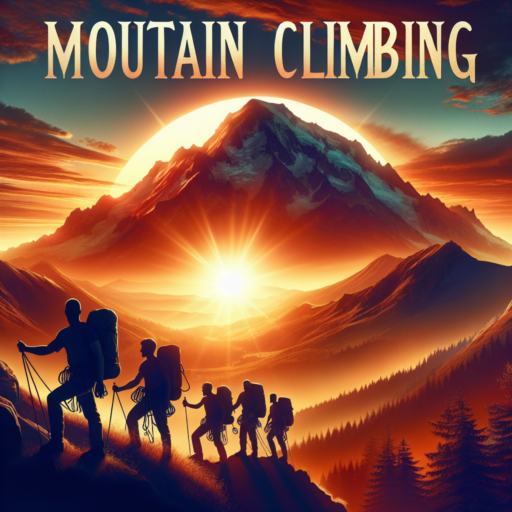Introduction to Mountaineering in English
Mountaineering, often described as the pinnacle of outdoor adventure, combines elements of hiking, rock climbing, and sometimes even glacier travel. This exhilarating pursuit not only demands physical endurance and technical skills but also a deep connection with nature. Embracing mountaineering opens up a world of breathtaking landscapes, from towering peaks to untouched snowfields, accessible only to those willing to rise to the challenge.
The history of mountaineering dates back centuries, with early ascents driven by exploration and scientific curiosity. Today, it has evolved into a multifaceted activity that appeals to adventurers seeking to test their limits. Whether it’s the quest for solitude, the thrill of exploration, or the pure challenge of scaling peaks, mountaineering offers something unique to each enthusiast.
Starting your journey in mountaineering involves a blend of physical preparation, skill acquisition, and understanding the environment. Key skills include navigation, weather forecasting, first aid, and understanding mountain hazards, such as avalanches and sudden weather changes. Aspiring mountaineers often begin with basic hikes, gradually moving on to more challenging terrain, under the guidance of experienced climbers or through mountaineering courses.
No se han encontrado productos.
Fundamental Mountaineering Terminology in English
Mountaineering, an adventurous and challenging sport, is filled with its own unique jargon. Understanding this terminology is not just about enriching your vocabulary; it’s about enhancing safety, efficiency, and camaraderie among climbers. Let’s delve into some fundamental mountaineering terminology that every aspiring climber should know.
Types of Climbs
In the realm of mountaineering, climbs are categorized to help climbers understand the nature and difficulty of the terrain. The most common terms include «alpine climbing», which refers to climbing in high mountains often involving rock and ice climbs, and «expedition climbing», which is typically a longer endeavor, requiring more equipment and preparation. There’s also «bouldering», a form of rock climbing on small rock formations or artificial rock walls without the use of ropes or harnesses.
Climbing Techniques
To navigate the vertical world, climbers must master several techniques. «Edging» involves placing the edge of the climbing shoe on a foothold, whereas «smearing» means using the rubber sole of the shoe to gain traction on a flat surface. Another key technique is «crack climbing», which entails inserting and twisting a part of the body into a crack to ascend. These techniques require practice and precision, highlighting the skillful nature of mountaineering.
As we explore the fundamental mountaineering terminology, we unlock a deeper appreciation for the sport. The right terms not only facilitate clearer communication among climbers but also open up avenues for learning and growth in the climbing community. Embracing these terms is a step forward in the exciting journey of mountaineering.
Essential Gear for Mountaineering: An English Guide
As the gateway to the peaks calls to adventurers and the landscapes whisper tales of the unforgiving, yet rewarding nature of mountaineering, the importance of having the right gear cannot be overstated. Navigating the world of mountaineering equipment can be daunting, especially when balancing the needs of weight, quality, and functionality. This guide aims to shed light on the indispensable gear that forms the backbone of any successful mountaineering expedition.
The Core Trio: Harness, Helmet, and Boots
- Harness: A critical piece for safety, the harness you choose must be both comfortable and versatile. It’s crucial for effectively attaching yourself to ropes and securing gear.
- Helmet: Protecting your head from falling debris and bumps, the helmet should be lightweight but incredibly durable. Its importance cannot be underestimated.
- Boots: Your feet are your primary mode of transport. Opt for boots that offer a balance between warmth, waterproofing, and technical capability.
In the realm of mountaineering, the adage «less is more» often applies, yet this doesn’t mean compromising on the essential equipment that ensures your safety and success in the mountains. Focusing on high-quality gear that addresses the fundamental demands of mountaineering not only elevates your experience but also shields you from the multitude of risks inherent in high-altitude adventures.
Understanding the Risks of Mountaineering and Safety Measures
Mountaineering, while an exhilarating and rewarding adventure, comes with its fair share of risks that should not be taken lightly. From the unpredictable weather conditions to the physical toll it takes on your body, being prepared and understanding these challenges is crucial for every climber. Knowledge and preparation can significantly mitigate these risks, ensuring a safer experience for all involved.
Common Rispects Associated with Mountaineering
- Altitude Sickness: As climbers ascend, the decrease in air pressure and oxygen can lead to altitude sickness, which can range from mild symptoms like headaches and nausea to life-threatening conditions such as High Altitude Pulmonary Edema (HAPE) and High Altitude Cerebral Edema (HACE).
- Weather Conditions: The weather on mountains can change swiftly and unexpectedly, leading to dangerous situations like avalanches, thunderstorms, and extreme temperature drops.
- Falls: Slippery surfaces, unstable snow or ice, and technical rock terrain increase the risk of falls, which can result in serious injuries or even fatality.
Essential Safety Measures for Mountaineers
- Proper Training: Gaining knowledge through seasoned guides, mountaineering courses, and thorough preparation is indispensable.
- Adequate Gear: Equipping yourself with the right gear, including appropriate clothing, safety equipment, and navigation tools, is vital for mitigating risks associated with mountaineering.
- Weather Awareness: Understanding and respecting the weather by constantly monitoring forecasts and adapting plans accordingly can make a significant difference in safety.
In sum, while the call of the mountains can be irresistible, understanding and preparing for the risks involved lays the groundwork for a safer and more enjoyable journey. By adhering to these safety measures, mountaineers can significantly reduce the inherent dangers that come with pursuing high-altitude adventures.
Top Mountaineering Destinations Worldwide for English Speakers
Mountaineering attracts adventurers from all corners of the globe, seeking to conquer peaks and explore untamed terrains. For English speakers, the quest for the next great ascent is made simpler by destinations renowned not only for their awe-inspiring heights but also for their accessibility and welcoming environment for those who navigate the world primarily in English.
The Magic of the Himalayas in Nepal
Nepal, home to the legendary Mount Everest, offers an array of peaks that cater to various levels of mountaineering expertise. While the language barrier might seem daunting at first, the mountaineering community, comprising experienced Sherpas and guides, often communicates effectively in English, facilitating a smoother expedition planning and execution. Besides Everest, peaks like Annapurna and Lhotse serve as majestic alternatives, each providing unique challenges and equally breathtaking vistas.
Adventures in the Rockies and Beyond
The Rocky Mountains, spanning across Canada and the United States, present another paradise for English-speaking mountaineers. With well-established trails, proficient guides, and a plethora of resources available in English, the Rockies offer an accessible yet thrilling experience. Regions like Colorado’s Rocky Mountain National Park and Canada’s Banff National Park are not only epic in their beauty but also in the diversity of climbs, from beginner to expert levels.
Mountaineering embarks you on journeys through the extremes of nature. It’s not just about the peaks but the stories, cultures, and connections made along the way. For English speakers looking to explore the world’s top mountaineering destinations, language complements the adventure, opening doors to experiences that resonate on a universal scale.
Preparing Physically and Mentally for a Mountaineering Expedition
Embarking on a mountaineering expedition is a challenging adventure that demands substantial physical and mental preparation. To ensure you are ready to face the rigors of the mountains, it’s important to focus on comprehensive training and psychological readiness.
Physical Preparation
Begin by building a solid physical foundation. This involves a mix of cardiovascular exercises, strength training, and endurance activities. Focus on running, cycling, or swimming to improve your cardiovascular health, which is essential for dealing with the thin air at high altitudes. Incorporate strength training exercises that target key muscle groups used in mountaineering, including the legs, back, and core. Additionally, incorporating activities that mimic the movements of mountaineering, such as hiking with a weighted pack, can be particularly beneficial for building endurance and getting your body accustomed to the type of physical exertion it will face on the expedition.
Mental Preparation
Mental readiness is just as critical as physical fitness when it comes to mountaineering. It is essential to develop resilience, adaptability, and a positive mindset. Start by setting realistic goals and visualizing successful outcomes to foster a positive attitude. Practice stress-management techniques, such as meditation and mindful breathing, to enhance your psychological endurance. Additionally, learning to stay calm and make clear decisions under pressure is invaluable and can be improved through scenario-based training or participation in high-intensity, dynamic sports.
Preparing for a mountaineering expedition requires a holistic approach that addresses both the physical and mental challenges of the adventure. By rigorously training your body and mind, you can increase your chances of success and ensure a rewarding experience on the mountains.
Mountaineering Training and Courses Available in English
Embarking on a mountaineering adventure necessitates not only physical preparation but also a solid foundation in technical skills and safety protocols. Fortunately, for English speakers, there is an abundance of mountaineering training and courses available that cater to various skill levels—from beginners to advanced climbers. These programs are designed to ensure that participants can safely enjoy the exhilarating experience of mountaineering, equipped with the knowledge and skills they need to navigate through the challenges posed by the rugged terrain.
Key Elements of Mountaineering Courses
Comprehensive mountaineering courses cover a wide range of crucial topics. Participants can expect to learn about weather analysis, route planning, and risk management, in addition to receiving hands-on training in the use of essential gear such as ice axes, crampons, and ropes. Moreover, these courses often put a strong emphasis on emergency preparedness and first aid, crucial skills for any mountaineer. Training in glacier travel and crevasse rescue techniques further prepares climbers for the complexities of navigating ice and snow-covered landscapes.
Benefits of Enrolling in English Language Courses
One of the significant advantages of enrolling in mountaineering courses offered in English is the accessibility of information. It allows participants from different parts of the world to converge and share experiences and techniques, fostering a global mountaineering community. Furthermore, English-language courses are often led by experienced instructors who can provide insights into the latest best practices and safety standards in mountaineering, making these programs invaluable for those looking to advance their climbing skills.
The Role of Weather in Mountaineering: An English Perspective
The importance of weather in the realm of mountaineering cannot be overstated, especially from an English perspective where the weather can be as unpredictable as the landscape is varied. Mountaineers and climbers venturing into the English hills, be it the rugged peaks of the Lake District or the rolling expanses of the South Downs, must always consider the pivotal role weather plays in their safety, enjoyment, and success on these adventurous endeavours.
Understanding Weather Patterns
For mountaineers in England, having a deep understanding of weather patterns is indispensable. Conditions in the mountains can change rapidly, turning what was a clear and sunny day into a challenging expedition fraught with visibility issues and slippery paths. Key to safe mountaineering is the ability to read these patterns and anticipate changes. This necessitates not only a keen sense of observation but also a reliance on accurate and up-to-date weather forecasts.
Navigating Challenges Posed by Weather
Weather does not merely shape the experience of mountaineering but also presents a array of challenges that climbers must navigate. Wind, rain, and fog are not uncommon in the English mountains, each bringing its own set of difficulties. Wind can make balancing precarious, rain can turn trails into treacherous paths, and fog can severely reduce visibility, making navigation a daunting task. Preparedness for these conditions is paramount, highlighting the need for appropriate gear, skills, and judgment.
Mountaineering Ethics and Environmental Conservation
Mountaineering, as an activity that draws adventurers closer to the high altitude wonders of nature, carries with it a responsibility towards environmental conservation. The principles of Leave No Trace have become more critical than ever in preserving these natural habitats. It is not just about the climb; it’s about respecting the mountains and ensuring they remain untarnished for generations to come.
In the realm of mountaineering ethics, the emphasis on minimal impact practices is paramount. Climbers are encouraged to stay on marked trails, reduce waste by packing out what they bring in, and avoid disturbing wildlife. The active role of each climber in conservation efforts helps in maintaining the pristine condition of mountain environments. This includes being conscious of their carbon footprint, which can be minimized by opting for eco-friendly transport and using sustainable gear.
Key Practices in Mountaineering and Environmental Conservation
- Adhering to Leave No Trace principles to minimize impact on natural surroundings.
- Prioritizing safety to not only protect individuals but also reduce the risk of harm to the environment.
- Engaging in clean climbing ethics by using equipment that doesn’t damage rock faces.
- Supporting conservation initiatives by participating in or contributing to preservation efforts.
By integrating these practices, mountaineers not only contribute to the sustainability of mountain ecosystems but also set a precedent for responsible outdoor recreation. The relationship between mountaineering and environmental conservation is symbiotic, where the preservation of nature ensures the enchantment of mountainous landscapes for future adventurers. Therefore, it becomes essential for the mountaineering community to advocate for and adhere to conservation principles.
Joining a Mountaineering Community: Tips for English Speakers
When English speakers venture into the vast and thrilling world of mountaineering, joining a community can significantly enhance their experience. Mountaineering communities offer a wealth of knowledge, essential safety information, and the camaraderie necessary for navigating the challenges of the mountains. However, for those whose first language is English, finding and integrating into these groups might seem daunting. Here are some indispensable tips to make the process smoother and more rewarding.
Understanding Local Language Nuances
While English is widely spoken, appreciating local language nuances in mountaineering terms and phrases can foster deeper connections. Start by learning key mountaineering vocabulary in the local language of the community you wish to join. This effort not only shows respect for the culture but also ensures clearer communication during critical moments on the mountain.
Utilizing Online Platforms and Social Media
Begin your journey by exploring online forums, social media groups, and websites dedicated to mountaineering in your area of interest. Many global mountaineering communities have English-speaking members or specific groups for English speakers. Engaging in these platforms can provide insights into the community’s activities, ethos, and how to join their next adventure.




